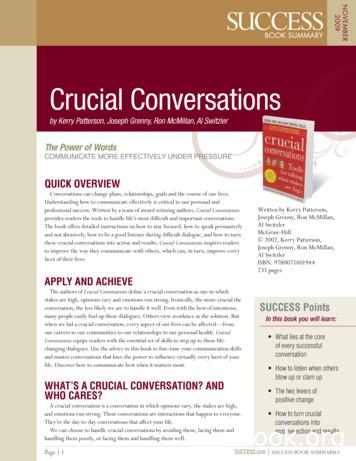Crucial Conversations: Effective Tactics For Setting .
The Precast ShowAGENDACRUCIAL CONVERSATIONS:EFFECTIVE TACTICS FORSETTING EXPECTATIONSAND EMPLOYEEACCOUNTABILITY IntroductionExpectationsYouYour EmployeesAtmosphere, Attitude and Morale – Invisible ForcesSetting, Communicating and Managing ExpectationsConfronting and Dealing with Poor PerformanceG. Terry Harris Sr.Director, Technical ServicesGCP Applied ation2YOUYOUR EMPLOYEES Boss, Supervisor, Leader, Responsible Person but notBuddy Be Self-Aware Recognize that they are all different people andprobably different than you Personalities Emotions Priorities Reactions Purpose Responses Realize that you do not know what’s going on in theirlives Set Self-Expectations Real, Reasonable and Measurable Be Honest in your Self-Evaluations Lying to yourself No Improvement Circumstances Concerns Conflicts Respond appropriately – NO MATTER WHAT! React quickly to issues Redeem if at all possible education4YOUR EMPLOYEESATMOSPHEREHire the right personTrain themCulture, Environment and Atmosphere Is it a “good”place to work? Put the right people in the right roles and give themthe right tools to meet reasonable expectations Have clear goals and expectations Take time to explain the 1“whys” Everything is a team effort and every team member isimportant We “pass or fail” as a team but we are individuallyresponsible for our performance Open communication and collaboration is cation61
The Precast ShowWHY DO PEOPLE DISAPPOINT ME!?ATTITUDES You can only control one attitude - yoursYou can influence employees attitudesDon’t complainDo not talk about one of your employees to anotheremployee Always end with a positive Decide to be a positive influence Fake it till you make LEEXPECTATIONSEmployee satisfaction, how the employee feels Praise for a job well done Recognition for team and individual accomplishment “We did it and you were a big part of it” “I didn’t meet expectations” Sorry seems to be the hardest word “Yes, that’s a great idea, let’s try it” Be an encouragementJob DescriptionFormal Onboarding ProcessNecessaryClear & Concise As much detail as needed Remove ambiguity Use pictures No colloquialismsMeasurable Comparable Number based Time EXPECTATIONSExplainable (Why)WrittenTeam and IndividualFlexibleExpectations are not goals The goal is to meet the expectations!COMMUNICATIONThe single biggest problem incommunication is the illusion thatit has taken place.– George Bernard on122
The Precast ShowCOMMUNICATINGEXPECTATIONSCOMMUNICATION “DON’TSAssume Knowledge Team Meetings Share your vision and goals for theteam One on one Ask 3 times Read the body language(Dangerous) Review what is written Agreement and Commitment Check in and provide feedback Day one Adjust quickly Are the expectations unreasonable You may expect more over time Ask questions Ability UnderstandingArgue Expectation setting are yours to set Discuss and DecideAccelerate Putting an unprepared employee in a role Shortening the training requiredAvoid Difficult employees Difficult Situations Owning your on14MANAGING EXPECTATIONSANNUAL PERFORMANCE REVIEWSManage UpI hate them Push back on unrealistic or unnecessary expectations Keep notes throughout the year Communicate the root cause for unmet expectations Communicate the plan for meeting expectations Use “we” not “they” in communications Review the annual review quarterlyOnly having performance reviews once a year doesn’twork Communicate any individual employee plans for improvementMake sure the expectations are attainable with theavailable tools, time and equipmentBe ConsistentManage your “expectation scale” New employees Previous experience “See something, Say something” Good and BadPerformance reviews like expectations and goals musthave clear guidelinesUsing the same “form” for every role doesn’t workFeedback and evaluations must be actionable“Fuzzy” evaluations are meaninglessAnticipate on16LEADERSHIP REVIEW360 REVIEWSeparate reality and perceptionFeedback from all viewpointsUsed successfully to reveal strengths and weaknessesCan be a great tool for any levelNeed to be anonymousSort out conflicts I think I’m a great communicatorHelps to get the team on the same page EngagementReveals areas for improvement A great opportunity to set an exampleOften reveals communication issues or communicationstyle issuesBuilds trustEncourages employees to ation183
The Precast ShowDEALING WITH PERFORMANCE ISSUESHouston, we’ve had aproblemDEFINITIONSCrucial Conversations - Holding a discussion between two ormore people where (1) stakes are high, (2) opinions vary, and(3) emotions run strong, seeking successful resolution andaction through respectful dialogue.2Crucial Confrontations - Holding someone accountable forbroken promises, violated expectations, or bad behaviorthrough candid and respectful dialogue in a way thatproblems are resolved, performance improves, andrelationships 192020CONFLICTSTYLES1. to come into collision or disagreement; be contradictory, atvariance, or in opposition; clash:2. to fight or contend; do battle.3. a fight, battle, or struggle, esp. a prolonged struggle; strife.4. controversy; quarrel: conflicts between parties. 5. discord ofaction, feeling, or effect; antagonism or opposition, as of interests orprinciples: a conflict of ideas.6. a striking together; collision.Competitive: Often used by people with power, rank, position, orexpertise.Collaborative: Used by people trying to meet the needs of all. Theycooperate effectively and bring viewpoints together.Compromising: Used by people who want to at least partially satisfyeveryoneAccommodating: Used by people willing to meet the needs ofothers at the expense of their own needs.Avoiding: Used by people who seek to evade the conflict entirely.They often delegate and accept ineffective decisions. This approachis usually ducation22EXAMPLESCONFLICT RESOLUTION STRATEGIES Behaviors Tardiness Absent w/o notification Treatment of others AttitudePerformance SlippagePerformance FailureInsubordinationAnnual ReviewCompensationNPCADeal with itIgnore n24244
The Precast ShowCONFLICT RESOLUTIONBE PREPAREDAcknowledge thatthere is a problem Have confidence that you have something important tosay, know the facts Have humility: You may not have the whole picture butcan add something to the picture Be skillful: Seek coaching so that you can rehearsewhat needs to be said in the right way Talk to someone who knows the person well** Be empathetic What outcome are you looking for? Will you settle for another 252626OUR BRAIN WHEN WE ARE NOTPREPAREDSET UP THE MEETING“Fight or Flight” syndromeleaves us to deal with the mostcomplex and challengingconversations of our lives with thesame set of skills we’d use to deal witha salivating predator.precast.org/education 2727Choose a private locationHave only the necessary parties there (No Spectators)Have a clear agendaHave a clear purposeprecast.org/education2828KNOW YOUR EMPLOYEEGETTING STARTED Make sure that good relationships are maintained: As faras possible, make sure that you treat the other calmlyand that you try to build mutual respect. Do your best tobe courteous to one-another and remain constructiveunder pressure;Other work issuesFamily problemsLikes & DislikesHow do they typically start conversationsHow do they react to “criticism”Keep people and problems separate: Recognize that inmany cases the other person is not just "being difficult"– real and valid differences can lie behind conflictingpositions. By separating the problem from the person,real issues can be debated without damaging workingrelationships;Pay attention to the interests that are being presented:By listening carefully you'll most-likely understand whythe person is adopting his or her education30305
The Precast ShowGETTING STARTEDGET THE CONVERSATION STARTEDListen first; talk second: To solve a problem effectivelyyou have to understand where the other person iscoming from before stating your own position;Set out the “Facts”: Agree and establish the objective,observable elements that will have an impact on thedecision; andExplore options together: Be open to the idea that a thirdposition may exist, and that you can get to this ideajointly. Ask questions to get things rollingConfirm answersParaphrase to acknowledge the storyPrime when you are getting nowhere, conversationstalls Write what you are hearing for better understandingUnderstanding a position does not mean you are NSELF AWARENESSJust because you’re talking it doesn’t meanyou’re having the right conversation! Be aware of your attitude – Physical and Mental Be aware of the impact of what you are saying has onyour employee Be aware of the impact on you of what the employee issaying Know when it’s time to end the meeting Know how to end the meeting Redirect the conversation if needed Avoid distractions, including phone calls, text andemails Don’t be surprised Look at “both sides” of the n3434DISCUSSIONRESOLUTION You and the employee agree that there is a performanceproblem and you develop an improvement planYou and the employee disagree and you still develop animprovement plan without employee inputYou and the employee agree that the expectations areunrealisticYou and the employee agree that the job isn’t right forhim and find him a different roleYou decide that termination is the only solutionKeep emotion out of your discussionAvoid arguing to make your argumentDon’t hide or make someone else the bad guyUse “I/We” not “you”Avoid emphasis on certain wordsIt needs to be a win/win not win/loseCapture the solution or resolution and next steps andreview with the cation35precast.org/education366
The Precast ast.org/education3838CRUCIAL CONVERSATIONS:EFFECTIVE TACTICS FORSETTING EXPECTATIONSAND EMPLOYEEACCOUNTABILITYG. Terry Harris Sr.Director, Technical ServicesGCP Applied Technologiesprecast.org/education39NPCA7
Crucial Conversations - Holding a discussion between two or more people where (1) stakes are high, (2) opinions vary, and (3) emotions run strong, seeking successful resolution and action through respectful dialogue. Crucial Confrontations - Holding someone accountable for broken promises, violated expectations, or bad behavior
1.1 Using Tactics in Practice 2 2 Tactics for Availability 5 2.1 Updating the Tactics Catalog 6 2.2 Fault Detection Tactics 6 2.3 Fault Recovery Tactics 10 2.4 Fault Prevention Tactics 16 3 An Example 19 3.1 The Availability Model 19 3.2 The Resulting Redundancy Tactic 21 3.3 Tactics Guide Architectural Decisions 22 .
Bruksanvisning för bilstereo . Bruksanvisning for bilstereo . Instrukcja obsługi samochodowego odtwarzacza stereo . Operating Instructions for Car Stereo . 610-104 . SV . Bruksanvisning i original
SOCIAL STYLE and Crucial Conversations 2 Overview The book "Crucial Conversations"1 provides advice for having conversations when failure is a strong possibility. The authors (Patterson, Grenny, McMillan & Switzler) provide a model for working through potentially disastrous conversations in a way that increases the chances
Difficult Conversations: How to Discuss What Matters Most by Douglas Stone The SPEED of Trust: The One Thing That Changes Everything by Stephen M.R. Covey About the Author This award-winning team of authors has produced three New York Times Best-Sellers: Crucial Conversations, Crucial Confrontations and Infl uencer. They are also sought-after
DESCRBING CRUCIAL CONVERSATIONS AND CONFRONTATIONS 1. A crucial conversation is a discussion between two or more people where: Stakes are high Opinions vary Emotions run strong 2. Crucial conversations are about disagreements. (Disagreements not handled well lead to: Strained relationships Poor decisions Disastrous results 3.
1. Understand the opportunity created by "Crucial Conversations" 2. Recognize & self-manage emotions during difficult conversations 3. Demonstrate skills needed to create & maintain psychological safety & mutual respect 4. Lead "Crucial Conversations" that result in interpersonal connection & growth What are your personal objectives? Page 2
tactics and discuss the range of tactics identified by research, as well as their effects on various outcomes. Impression management tactics Research has identified a range of IM tactics and has found several ways to classify these tactics. The simplest distinction views IM tactics as either verbal or non-verbal (Schneider, 1981).
ADHOME HVAC MARKETING FUNNEL AWARENESS INTEREST CONSIDERATION INTENT EVALUATION PURCHASE DESCRIPTION MARKETING TACTICS MARKETING TACTICS MARKETING TACTICS MARKETING TACTICS MARKETING TACTICS MARKETING TACTICS DESCRIPTION DESCRIPTION DESCRIPTION DESCRIPTION DESCRIPTION Someone in this stage is hearing about your brand for the first time. They .























